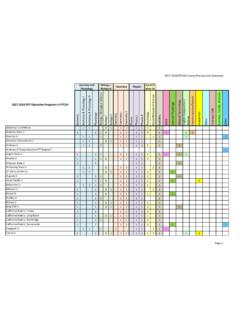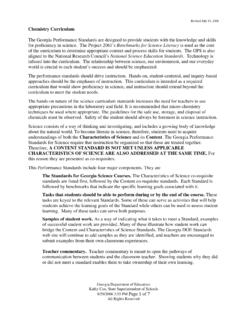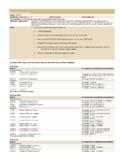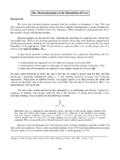Transcription of Determination of the Molar Mass of a Volatile …
1 Determination of the Molar mass of a Volatile Liquid by Vapor Density Background Chemical and physical methods for determining atomic and molecular formula weights or Molar masses have been important historically as a way of analyzing and categorizing new materials. The modern laboratory is generally equipped with instrumentation which makes many of these methods obsolete. However the principles upon which the older methods were based are not insignificant and many form the foundation for the prediction of physical and chemical properties and behaviors of substances.
2 The classic Dumas method for determining the formula weight of a Volatile liquid is a case in point. Avogadro proposed as early as the mid-1800's that equal volumes of gases measured under identical conditions would contain equal numbers of gas particles. With an established relative atomic mass scale it was possible to describe a constant volume which would contain a gram-atomic weight of a gaseous element or compound under fixed conditions, what we know today as the Molar volume. At STP this volume is L for an ideal gas.
3 An understanding of the various gas laws allows for an application of this useful information to liquids and solids which are appreciably Volatile , , possess relatively high vapor pressures. As long as the temperature and pressure are known, a measured volume of gas can be converted to moles since: PVn = RT Massing a sample of gas is relatively simple. These two pieces of information are the minimum required for a Molar mass Determination . In the Dumas method a Volatile liquid is heated to a known temperature (above its boiling point) and allowed to escape from a container through a tiny orifice.
4 Once the liquid has vaporized, the container is cooled to room temperature. Gradually the vapor which remained in the container at the higher temperature condenses to a liquid and is then massed. If the volume of the container is known along with the high temperature, the room pressure can be used (because the system is open to the atmosphere through the orifice) to calculate moles. From there a Molar mass can be determined. This method depends on a lot of things going right. One assumption is that while the liquid is Volatile enough to vaporize at the elevated temperature, it is not so Volatile that a significant amount will be lost to evaporation through the orifice as the container cools.
5 The vapor is also assumed to behave ideally at the temperature and pressure at which it occupies the container. The amount of error implicit in this approximation varies from compound to compound and is tied to the variables which create deviations from ideal behavior: molecular volume and intermolecular forces. Generally speaking, the larger these are, the greater the error in the Determination . The situation is further complicated by the interaction of these two factors. For example, a small molecule may have significant intermolecular forces (hydrogen bonding perhaps) but a large molecule may have comparatively weak forces (like dispersion forces).
6 Combinations run between these extreme examples making predictions of error from this source difficult. Adapted from Experimental Studies for General Chemistry, Malcolm F. Nicol, Arlene A. Russell, Eleanor D. Siebert 26 Laboratory Manual for Chemistry, Lawrence Epstein There is another problem with the basic method which is more easily addressed. When the container is "empty", , before the liquid is added or the vapor forms, there is a fixed amount of air determined by the volume, temperature and pressure in the container.
7 This air has mass and contributes to the overall mass of the container assembly. But when the liquid is present it vaporizes to some extent determined by its vapor pressure at room temperature. The presence of this vapor forces out some of the air through the orifice since the internal pressure is equalized with the room pressure and the number of gas particles remains constant if the temperature and pressure remain constant. Thus when the container is massed again there is air missing that should be counted in the final mass if the mass of the condensed liquid is to be determined by difference.
8 This results in an apparent mass of liquid that is too small which in turn makes the Molar mass calculation too small. The moles of air forced out by the vapor are equal to the moles of vapor that forms. This is determined by the vapor pressure of the liquid at room temperature. If this value is known, the moles of vapor that are present in the flask above the residual condensed liquid can be calculated as: vaporcontainervaporPVn = RT Avogadro's Law tells us that these moles of vapor must equal the moles of air displaced since the conditions are the same for both.
9 These "missing" moles of air can be converted to grams using the weighted average Molar mass of air and added into the final mass of the assembly. All of this depends, of course, on knowing the vapor pressure of the liquid, Pvapor. The value could be determined experimentally but for the purposes of this experiment a list of possible unknowns and their vapor pressures at 298 K will be provided. The Experiment The Molar mass Determination should be done at least twice. The following non-locker materials will be provided: aluminum foil fine copper wire razor blades, pliers, wire cutters, etc.
10 Boiling stones 600 mL beaker hypodermic syringe The Chemicals The unknowns used in this experiment include the following: acetonitrile ( g/mol, vp298 = 81 mmHg, bp = ) or ethanenitrile is a poisonous liquid with an ether-like odor. It is soluble in water and most common organic solvents. Like acetone, it forms a low-boiling azeotrope with water. It is used in many organic syntheses and wherever a polar solvent with high dielectric constant is required. Breathing the vapors should be avoided. Skin contact may cause irritation.








